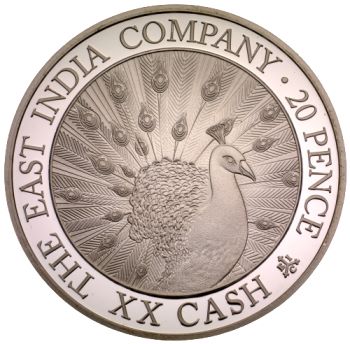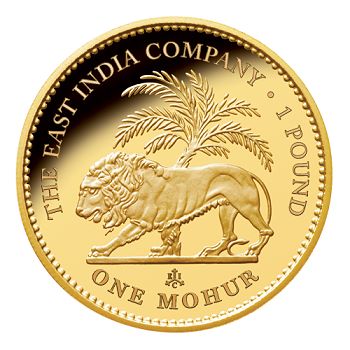LONDON, ENGLAND, – Over three hundred years after The East India Company was first given the right to mint its own currency by Charles II in 1677, the company has announced the issue of its legal tender coins returning to its by-gone days in the bullion trade. The Limited Edition gold proof coins are struck by the Royal Mint, who first minted coins for The East India Company over two hundred years ago.
 The coin designs are inspired by the main trading currencies The East India Company used in the 17th – 19th century ─ CASH and Mohur. The silver ‘CASH’ proof coins features a peacock design symbolizing immortality and rebirth and are available in a 1/2oz and 1oz coin equivalent to a 10p and 20p respectively.
The coin designs are inspired by the main trading currencies The East India Company used in the 17th – 19th century ─ CASH and Mohur. The silver ‘CASH’ proof coins features a peacock design symbolizing immortality and rebirth and are available in a 1/2oz and 1oz coin equivalent to a 10p and 20p respectively.The gold Mohur proof coins bear the famous Lion & Palm Tree motif denoting wealth and prosperity and are available in a half and one Mohur coin equivalent to 50p and £1 respectively
 The Limited Edition East India Company proof coins can be purchased mail order or by visiting The East India Company store on Conduit Street, London. In addition the company is making the gold and silver coins available through a network of bullion dealers worldwide.
The Limited Edition East India Company proof coins can be purchased mail order or by visiting The East India Company store on Conduit Street, London. In addition the company is making the gold and silver coins available through a network of bullion dealers worldwide.Commenting on the launch of their legal tender coins Sanjiv Mehta, Managing Director and Chairman of The East India Company, said: “The East India Company is proud to present its first silver and gold coins. The company has been known in the precious metal trade since 1800. It was and still is the only corporate in history to mint its own trading currency. It made sense to commission our own silver and gold coins in this day and age. The precious metal trade formed an important part of The East India Company’s trading activities and we plan to re-establish this position for the company today.”
About The East India Company
In 2005 Sanjiv Mehta, an Indian Entrepreneur, acquired the East India Company (EIC) from 33 different share holders. Following which, the company spent five years and invested over £20 million to rebuild and position The East India Company as a luxury brand today.The East India Company was relaunched on 15th August 2010 with its first flagship ‘Fine Food’ store in Conduit Street, London.
On 24th December 2010, less than six months following the company’s relaunch, the Mahindra Group takes a minority stake in the East India Company. The companies commence a long-standing relationship with significant investment to perpetuate the growth of the world’s oldest international brand.
“The East India Company was the world’s first truly global brand spanning continents and centuries, and had a profound impact on the development of international trade. This immense vision and scope finds a parallel with Mahindra’s own global aspirations to think beyond its size. We are absolutely delighted to be associated with such a prestigious brand and look forward to further enhancing its equity across the world,” said Mr. Anand mahindra Vice Chairman and Managing director, Mahindra Group.
EIC is a multi-channel business dealing with precious metals, fine food, bespoke furniture, real estate, publishing, fashion, art and jewelry.
With the huge emotional connect between its brand and the nations it once served The East India Company has already acquired an inspiring following since its re-launch in 2010 and is completely devoted to continue to build its cross-category product and services portfolio delivering surprising, exotic and above all authentic customer experiences.
Sanjiv Mehta describes The East India Company as a merchant business with a pioneering spirit, constantly seeking the critical ingredients required for success. He comments, “The East India Company holds limitless opportunities across many products, sectors and countries. We are determined to capitalise on the strong legacy and enviable heritage of our brand”.
The East India Company and the History of CASH and the Mohur
The origins of the term ‘CASH’ as we know it today comes directly from the East India Company heritage. Cash coins were minted on behalf of the East India Company by the Madras Mint as early as 1660 – 1661. As The East India currency developed, the word ‘cash’ was used in a general sense to denote practically any copper coin, which was current in a particular locality.
Originally struck in 1835, the Mohur is one of the most iconic coins minted by The East India Company. Meaning symbol or seal, the Mohur first appeared as long ago as 1540. Originating from the Mughal Empire in India, it was the highest unit of currency in a system that also featured a silver coin called the Rupiya – later known as the Rupee, the national currency of India.
History of Trading Precious Metals
In the early 17th century The East India Company was already heavily associated with the export of precious metals from England. The Company was unable to trade goods of European production due to a lack of demand for the heavy English woollen cloth and other European goods in the Asian markets. Consequently the English merchants had to pay for their imports with silver and gold. The East India Company became one of the two largest bullion traders of their time, the other one being the ‘Baltic Traders’.
In 1677 Charles II granted The East India Company the right to mint its own coins in the territories it adopted. From 1716 to 1835, the Company established 14 mints across India, including Bombay, Calcutta and Madras.
By 1835 the ‘Coinage Act’ ruled for a universal currency to come into effect for all the colonies. At this time the Mohur coin was struck for the first time bearing King William VI effigy and the memorable ‘Lion and Palm Tree’ motif.
Source @CoinWeek